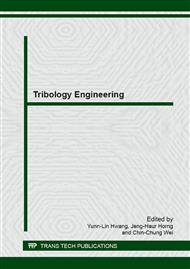p.94
p.99
p.104
p.110
p.115
p.120
p.125
p.130
p.135
Experimentally Investigate the Vortex Ferro-Viscosity under Directional Field
Abstract:
In this study, apparent ferro-viscosity on applied directional field, through the evaluation of mean piping flow velocity, is examined. Here viscosity in magnetized ferro-flow is found to be closely dependent on the field intensity as well as direction, which is quite different from the constant thermal property usually used in traditional fluid dynamics problem. To predict ferro-magnetization and ferro-viscosity induced under horizontal and vertical field imposed , an auxiliary electromagnetic mechanism is then designed and set up ,As a result, the apparent viscosity ,for ferro-concentration ψ0.4 and 0.04 exposed to field in different direction, will initiate a faster growth within field strength of 6~12 mT where the quick magnetization of ferro-particles starts working, and magnetic field along with flow direction is found to have more potential to induce viscous drag. While compared with theoretic results on Brownian relaxation theory in Langevin function, experimental vortex viscosity behave a good agreement within the working magnetic intensity 0~36 mT and their maximum relative errors will be less than 10% and 50% for ferro-concentration ψ0.4 and 0.04 at working temperature at 25 o c.
Info:
Periodical:
Pages:
115-119
Citation:
Online since:
April 2015
Authors:
Price:
Сopyright:
© 2015 Trans Tech Publications Ltd. All Rights Reserved
Share:
Citation:


